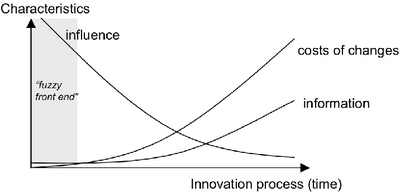Front-end Sustainability: Initiating the right sustainable projects
Developed by Kristine Fisker
Projects shape society and our world permanently, by shaping the impact of the products, buildings, infrastructure, policies and systems designed within them. One of the most critical questions for project management going forward will be how to aid in tackling the large, complex, and interlinked sustainability challenges that need to be solved for societies worldwide to be sustained and prosper[1].
The Front-End of Innovation, sometimes referred to as the Fuzzy Front-End (when project ideas and concepts are searched for, defined, and evaluated for further development), is the stage which is most critical in determining the impact of a project, yet the Front-End of Eco-Innovation has received little attention by the field of project management [1] [2] [3]. Instead, management principles for the Front-End of Innovation can be found in the field of design[4].
This article will provide a high level overview of considerations and frameworks that project, program and portfolio managers can apply to transform front-end processes for increased sustainability impact of their projects, which can increase resilience and opportunity creation for their organizations. As the link between front-end innovation and sustainability is an emerging field of study, this article combines current best practices within front-end management- and sustainability management.
Contents |
The Front-End: An Overlooked Key to Sustainable Impact

Companies that develop solutions to achieve the Sustainable Development Goals (SDGs) can discover new growth opportunities and reduce risk to their continued operation. As governments and international organizations keep increasing efforts to deliver on the SDGs, it will strengthen the financial value of corporate sustainability, e.g. as taxes and pricing mechanisms are introduced to internalize externalities [6]. Eco-innovation will thus become an increasing source of competitive advantage, and mastering the front-end of environmental innovation could be crucial for business success and longevity [2].
The Front-End is the most uncertain, challenging part of projects, while at the same time being the part of the project that has the largest influence on final project impact[5][7](see Figure 1). Investing in the front-end project development is generally described as having one of the highest payback of possible investments [7]. To achieve a high level of sustainability rather than a lower level, companies must integrate sustainability considerations into the early stages of the innovation process, as this is the phase where fundamental project requirements are defined, that will often not be possible to be changed later[2].
Application
Advice and frameworks for managing front-end innovation and sustainability is summarized here in 4 steps of increasing complexity in the following.
1. Know to challenge initial ideas and manage the search for impactful concepts
Realizing the potential and the common pitfalls in front-end innovation management, and allocating resources to manage the front-end, is the very foundation of sustainable project impact.
In numerous projects, the initial solution idea goes unchallenged and eventually becomes the chosen project concept [1] [2][8], and the common practice of today is to apply downstream analysis of a given alternative, rather than upstream evaluation of alternative concepts based on needs, goals and priorities[8]. This tendency to define projects based on a preconceived idea of solution to the problem at hand is understandable, as the front-end can otherwise seem to have too few constraints to be managed. Going with a preconcieved solution from the beginning can however be highly problematic, as the initial solution idea often is based on a large amount of assumptions, and not ideal in terms of appropriateness or impact towards the desired outcomes [9]. This is especially problematic for sustainability, as the amount of impacts and trade-offs to be considered and evaluated is even higher than in traditional projects [8]. It is suggested that companies could prevent a significant amount down-stream sustainability issues from arising, by reallocating resources towards front-end innovation, where sustainability issues can be designed out of the future portfolio[3][2].
To exemplify, it is a common strategy for the building departments of organizations to base all their sustainability projects on how to build more buildings, parking lots, etc. with minimal environmental impact, but not to consider initiating projects that map which buildings they could entirely avoid building based on e.g. increased digitization of work, or optimization of the utilization of current space. For a manager in such an organization to simply become aware of this scoping bias and encourage further solution exploration based on desired outcomes, could have a significant potential in reducing the organizations' emissions and resource consumption.
2. Create conditions for explorative Front-End Innovation
If you as a manager have been convinced of the potential value of prioritizing front-end eco-innovation, next step is to figure out how to systematically do so.
2.a Setting value-based priorities and goals
Using value-based prioritisation and goal setting is key to avoiding assuming solutions, as described in the first section. Good management of priorities and goals for the organization portfolio, for programs within the portfolio, and for individual projects is commonly described as a key step to successfully achieving impact towards sustainability[6][10][11]. This can sound obvious, but explicitly formulating and prioritising goals is instrumental in keeping employees and external stakeholders aligned on the desired outcome, to ensure working in the same direction, to avoid excessive scope creep, and to avoid fixating on specific solution paths rather than desired outcomes.
The UN Sustainable Development Goals is one of the most recognized set of defined sustainability goals with defined indicators for each goal. The SDG Compass is a systematic guide for businesses to use the SDGs to define priorities, set goals and integrate them into operations, and can be accessed here. It is summarized briefly in the wiki-article Sustainability in Project and Portfolio Management.
Methodologies for managing value-based priorities and goals include Requirement Management, Goal Hierachy, Benefits Realization Management (BRM), Objectives and Key Results (OKR), which s
2.b Apply design competencies to manage front-end innovation
The 'fuzzy' front-end can in fact become less fuzzy, and can be flexibly managed with appropriate tools, skillets and experience. Design have become the main framework for managing innovation, and designers and design engineers are increasingly utilized for their competencies and methodologies in navigating and facilitating value-based concept exploration and the complexity and uncertainty of front-end innovation[4].
2.c The Front-End Innovation Unit
Several sources suggest a small Front-End Innovation/Delivery Unit/Lab/Incubator, including McKinsey[1] and the Danish Design Center[12] and others[3]. This team should be dedicated to systematically working with the front-end, to ensure official responsibility for exploring the front-end, before project scopes are assumed, and to build front-end competencies within the organization. Because the ideal pace of front-end innovation is iterative and rapid, a smaller team is preferred. Recommendations and insights for managers of innovation units can be found in a report by the Danish Design Center Diving deep into corporate innovationCite error: Closing </ref> missing for <ref> tag)
Larger than any one organization - benefits beyond the individual organization.
Balancing challenging and maintaining the established
References
- ↑ 1.0 1.1 1.2 1.3 Morris, Peter W. G. 2017. Climate Change and What the Project Management Profession Should Be Doing about It - a UK Perspective. APM, UCL.
- ↑ 2.0 2.1 2.2 2.3 2.4 Bocken, N. M. P., M. Farracho, R. Bosworth, and R. Kemp, 2014. The Front-End of Eco-Innovation for Eco-Innovative Small and Medium Sized Companies, Journal of Engineering and Technology Management 31:43–57. Available at: https://www.repository.cam.ac.uk/bitstream/handle/1810/245338/The-front-end-of-eco-innovation_final__open-access.pdf?sequence=1 )
- ↑ 3.0 3.1 3.2 Sherwin, Chris, 2017. The Fuzzy Front-End of Sustainability, Edie. (https://www.edie.net/the-fuzzy-front-end-of-sustainability/) )
- ↑ 4.0 4.1 Hernández, Ricardo J., Rachel Cooper, Bruce Tether, and Emma Murphy. 2018. “Design, the Language of Innovation: A Review of the Design Studies Literature.” She Ji: The Journal of Design, Economics, and Innovation 4(3):249–74.
- ↑ 5.0 5.1 Figueiredo, João, N. Correia, I. Ruivo, and J. L. Alves. 2015. “A Cross-Functional Approach for the Fuzzy Front End: Highlights From a Conceptual Project.” in International Conference on Engineering Design ICED15. Milan, Italy. (https://www.semanticscholar.org/paper/A-CROSS-FUNCTIONAL-APPROACH-FOR-THE-FUZZY-FRONT-A-Figueiredo-Correia/717996dc452bfc56468287064373c468d8de282b)
- ↑ 6.0 6.1 United Nations, FRI, and wbcsd. n.d. “SDG Compass - The Guide for Business Action on the SDGs (https://sdgcompass.org/).”
- ↑ 7.0 7.1 Dewulf, Kristel. 2013. "Sustainable Product Innovation: The Importance of the Front-End Stage in the Innovation Process." in Advances in Industrial Design Engineering. IntechOpen.
- ↑ 8.0 8.1 8.2 Olsson, Nils O. E., and Knut Samset. 2006. “Front-End Project Management, Flexibility, and Project Success.” in PMI® Research Conference: New Directions in Project Management, Montréal, Québec, Canada. Newtown Square, PA: Project Management Institute.
- ↑ Cross, Nigel. 2000. Engineering Design Methods: Strategies for Product Design. 4th ed. John Wiley And Sons Ltd.
- ↑ Stock, Tim, Michael Obenaus, Amara Slaymaker, and Günther Seliger, 2017. A Model for the Development of Sustainable Innovations for the Early Phase of the Innovation Process, Procedia Manufacturing 8:215–22. Available at: https://www.sciencedirect.com/science/article/pii/S2351978917300331?via%3Dihub
- ↑ Green Project Management GPM. 2019. “P5TM Standard for Sustainability in Project Management Version 2.0.”
- ↑ Bason, Christian. 2023. “Embracing a New Leadership Role for the Future: Mission Managers.” Danish Design Center. Retrieved May 3, 2023 (https://ddc.dk/mission-managers/)
